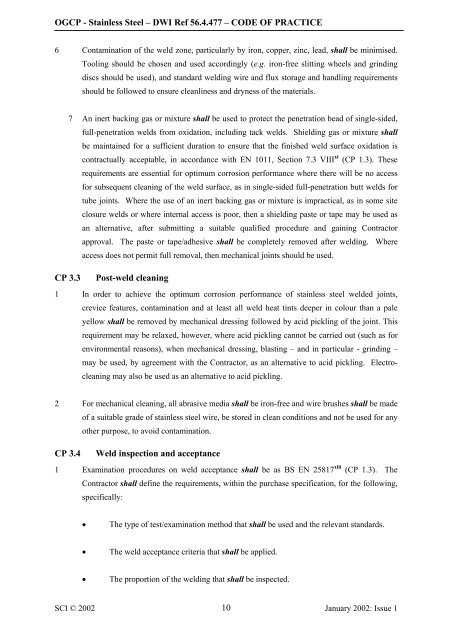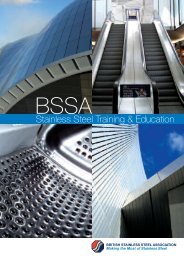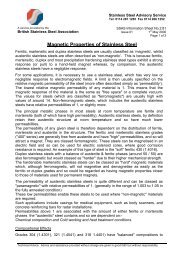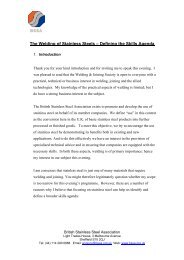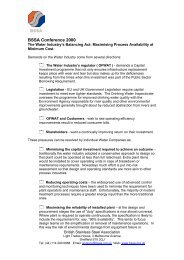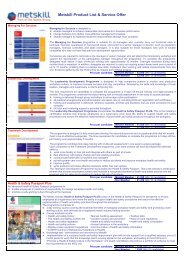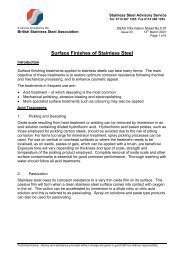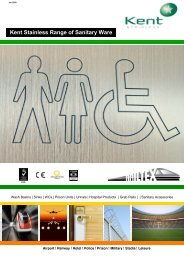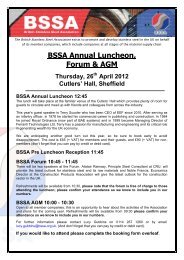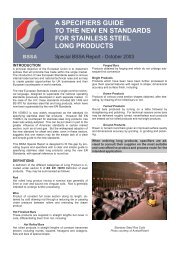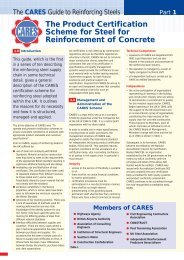Operational guidelines and code of practice for stainless steel
Operational guidelines and code of practice for stainless steel
Operational guidelines and code of practice for stainless steel
You also want an ePaper? Increase the reach of your titles
YUMPU automatically turns print PDFs into web optimized ePapers that Google loves.
OGCP - Stainless Steel – DWI Ref 56.4.477 – CODE OF PRACTICE<br />
6 Contamination <strong>of</strong> the weld zone, particularly by iron, copper, zinc, lead, shall be minimised.<br />
Tooling should be chosen <strong>and</strong> used accordingly (e.g. iron-free slitting wheels <strong>and</strong> grinding<br />
discs should be used), <strong>and</strong> st<strong>and</strong>ard welding wire <strong>and</strong> flux storage <strong>and</strong> h<strong>and</strong>ling requirements<br />
should be followed to ensure cleanliness <strong>and</strong> dryness <strong>of</strong> the materials.<br />
7 An inert backing gas or mixture shall be used to protect the penetration bead <strong>of</strong> single-sided,<br />
full-penetration welds from oxidation, including tack welds. Shielding gas or mixture shall<br />
be maintained <strong>for</strong> a sufficient duration to ensure that the finished weld surface oxidation is<br />
contractually acceptable, in accordance with EN 1011, Section 7.3 VIII xi (CP 1.3). These<br />
requirements are essential <strong>for</strong> optimum corrosion per<strong>for</strong>mance where there will be no access<br />
<strong>for</strong> subsequent cleaning <strong>of</strong> the weld surface, as in single-sided full-penetration butt welds <strong>for</strong><br />
tube joints. Where the use <strong>of</strong> an inert backing gas or mixture is impractical, as in some site<br />
closure welds or where internal access is poor, then a shielding paste or tape may be used as<br />
an alternative, after submitting a suitable qualified procedure <strong>and</strong> gaining Contractor<br />
approval. The paste or tape/adhesive shall be completely removed after welding. Where<br />
access does not permit full removal, then mechanical joints should be used.<br />
CP 3.3 Post-weld cleaning<br />
1 In order to achieve the optimum corrosion per<strong>for</strong>mance <strong>of</strong> <strong>stainless</strong> <strong>steel</strong> welded joints,<br />
crevice features, contamination <strong>and</strong> at least all weld heat tints deeper in colour than a pale<br />
yellow shall be removed by mechanical dressing followed by acid pickling <strong>of</strong> the joint. This<br />
requirement may be relaxed, however, where acid pickling cannot be carried out (such as <strong>for</strong><br />
environmental reasons), when mechanical dressing, blasting – <strong>and</strong> in particular - grinding –<br />
may be used, by agreement with the Contractor, as an alternative to acid pickling. Electrocleaning<br />
may also be used as an alternative to acid pickling.<br />
2 For mechanical cleaning, all abrasive media shall be iron-free <strong>and</strong> wire brushes shall be made<br />
<strong>of</strong> a suitable grade <strong>of</strong> <strong>stainless</strong> <strong>steel</strong> wire, be stored in clean conditions <strong>and</strong> not be used <strong>for</strong> any<br />
other purpose, to avoid contamination.<br />
CP 3.4 Weld inspection <strong>and</strong> acceptance<br />
1 Examination procedures on weld acceptance shall be as BS EN 25817 xiii (CP 1.3). The<br />
Contractor shall define the requirements, within the purchase specification, <strong>for</strong> the following,<br />
specifically:<br />
• The type <strong>of</strong> test/examination method that shall be used <strong>and</strong> the relevant st<strong>and</strong>ards.<br />
• The weld acceptance criteria that shall be applied.<br />
• The proportion <strong>of</strong> the welding that shall be inspected.<br />
SCI © 2002 10<br />
January 2002: Issue 1


